After Bentley Systems’ annual customer event, BE, was cancelled this year due to the economic conditions, the company held an intimate summit in Charlotte, North Carolina, to announce its news and the winners of its annual infrastructure awards. Martyn Day attended the event.
The 112-storey Lotte Super Tower proposed for Seoul, South Korea, is a 550-metre-tall, mixed-use building with a steel diagrid structural system. The exterior structural diagrid has 68 unique (432 total) joints at which six major members come together at a single point. Morphing from a square base to a circular top, the building geometry posed a technical challenge for the structural engineering team.
The team developed custom tools to manage the diagrid connection geometry, enabling it to create accurate physical and analytical 3D models of the structure. MicroStation and Bentley structural software provided the main interface to the custom application used to parametrically describe and manage the node connections. The 3D model supported creation of 2D and 3D drawings and the provision of accurate digital information to the steel supplier/fabricator.
Traditionally Bentley’s BE event attracts thousands of customers from around the world to hear the latest in design and management technology, attend classes, meet the programmers and have some quality social time. These huge user events take years to organise and unfortunately the financial crisis struck during the planning stages for the 2009 event. This has impacted the majority of global infrastructure projects with the net result of losses, redundancies and Bentley’s customers imposing stringent travel restrictions inhibiting their ability to attend software jamborees.
As an alternative, Bentley held a small, invite only event in Charlotte, North Carolina, in October, to deliver its keynotes and updates and host the gala evening for the company’s annual BE Inspired awards. So instead of 3,000, we were just 300 but the hospitality and information was far from Spartan.
Happy Birthday
This year also happens to be Bentley Systems’ 25th anniversary. This is a major milestone, especially when the Bentley’s reminded us that the company has only changed the DGN file format once in its history — not, as Greg Bentley pointed out, multiple times like its competitors to drive sales. Bentley started out with brothers Keith and Barry Bentley developing a package they called PseudoStation to allow users of Intergraph’s VAX systems to view and modify their designs on general-purpose workstations.
With the rise of the PC, that product became MicroStation and what was a small family business became a global giant, employing 2,700 people (including three more Bentley brothers) in 50 countries with annual revenues over $500 million. These numbers make Bentley one of the biggest privately held software firms in America and number two provider to architecture, engineering, construction and GIS/geospatial markets.
Bentley’s product range has expanded by development and acquisition and includes famous brands such as ProjectWise, InRoads, STAAD, Generative Components, AutoPlant, Hevacomp, PlantSpace, Haestead and RAM. Bentley’s products and customers tend to be at the larger scale of the engineering business, servicing 86% of the Engineering News Record’s Top 500 design firms.
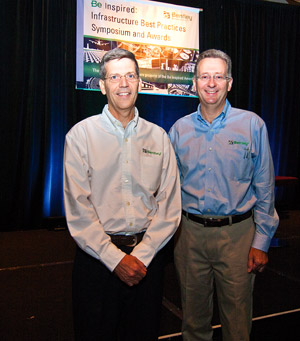
To cater to its customers Bentley has established the most extensive back office system out of any of the CAD vendors, having a server-based access to and distribution of software, training and support, as well as offering flexible licenses to mix and match product sets as and when required.
The company’s key product is still MicroStation, which has undergone continual development since its inception in 1986 and has grown from being a 2D drawing system to a full 3D modelling tool used to prototype everything from the most complex signature architect’s buildings to bridges and massive road and rail networks. Twenty-five years later and, from the event’s news, Bentley looks set to keep gong strong.
Greg Bentley
It has undoubtedly been a tough year but Greg Bentley remained upbeat about the opportunities for the Infrastructure market and the company. There is a lot of talk in the US about stimulus money and it appears some of this is trickling through, especially to rail and road networks — areas where Bentley dominates.
In the last 25 years, Bentley has spent over $1 billion in research and development, building an extensive portfolio of products across multiple markets. While the development continues, so do the acquisitions, with Bentley announcing at the event that it is purchasing Bridgemaster, the leading bridge design solution in the Chinese market, as well as gINT Software, which extends data management of Information modelling below the surface for new Geoenvironmental opportunities. Greg Bentley also announced the acquisition of 9SQ Corporation, a South Korean-based developer of plant services, adding its PlantWAVE products to the Bentley portfolio, which brings clients like Daewoo Shipbuilding, Hyundai Heavy Industries and Samsung Engineering.
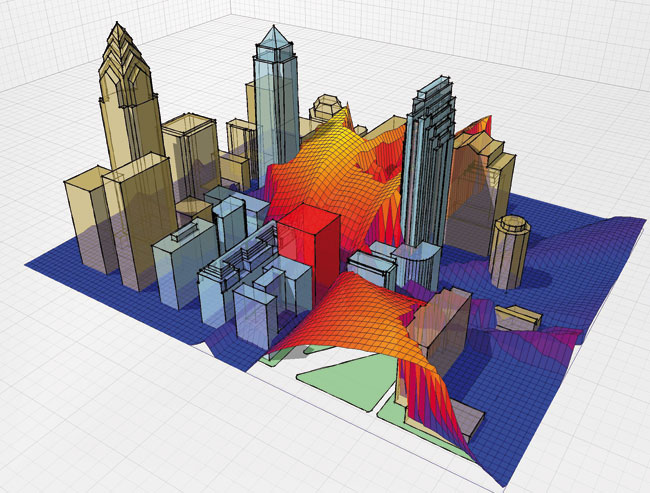
Extending and adding new runways at Chicago O’Hare International airport, while keeping it fully open, has been achieved using ProjectWise.
Bentley has moved to allow customers to pool licenses at a country-level. This is a great cost-effective change to the company’s licensing policy, which previously only allowed site-based license sharing. There is also a new Passport annual licensing option for individuals, which includes extensive bundles of Bentley’s high-end products.
Keith Bentley
In his address, Keith Bentley took a trip down memory lane and looked at the company from when it just had two employees, together with some of the very early versions of MicroStation, which was pretty amusing.
Keith then examined the federated workflows that dominate the Infrastructure space. Customers use all types of software, with many different formats, many different standards over multiple places. Despite all the technology available, it is a tough place to operate in and because of this Bentley is concentrating on trying to improve the connectivity and interoperability between software and companies. As part of this strategy, Bentley has come up with an intriguing new format to store project data called an ‘i-model’, which is essentially an expanded DGN file.
Bentley’s product suite has been expanding in scope and reach from 2D to 3D, analysis to project management and this is set to continue. The company sees an expansion in the use of point cloud data and has signed an agreement with London-based Pointools to include its technology in future Bentley products. This deal is in addition to the existing deal that Bentley has with Leica for its CloudWorx software.
Looking towards the future Keith Bentley pointed out that just after they had started the company, he needed to buy a back up drive and paid $2,000 for a ‘huge’ 10Mb drive. His wife’s laptop recently died and while it originally had a 200Gb drive he had to order a 500Gb replacement for $89 as the 200Gb drive was not made anymore. Keith Bentley mused that if he had wanted 500Gb of data storage in 1986, it would have cost him $100 million! The prices of computing continue downward, while the power and storage on the desktop continues to accelerate. The future is multiple cores and one day we could see affordable desktop computers with as many as 1,000 cores, he suggested.

While there has been a lot of talk of the cloud, Keith Bentley could see that some services would perhaps move to an Internet-delivered service but did point out that with Bentley’s Select subscription and server delivery, Bentley’s products and infrastructure were already, in some way, software as a service.
Offstage, Keith Bentley divulged a secret: he had bought himself an Apple iPhone. Keith Bentley is not traditionally an Apple hardware fan, but he could not help himself extol the virtues of the iPhone and how it is so good he threw his Kindle reader away (metaphorically) and now even reads books in bed on it. I would not hold your breath for an OSX version of MicroStation anytime soon but I would not be surprised to see Bentley ‘have an app for that’ in the near future.
Pointools
At the event, Keith Bentley announced that it has entered into a technology agreement with Pointools, a leader in high-performance point cloud manipulation. Point clouds are literally a cloud of 3D points, captured by 3D laser scanners and can be used to accurately capture infrastructure assets such as plant, buildings and roads, as well as land from aerial LiDAR (Light Detection And Ranging) surveys. The agreement allows Bentley to license Pointools’ Vortex API engine, together with ongoing upgrades, for incorporation in to MicroStation and all other software products that use Bentley’s platform technology.
The Vortex engine is widely renowned as being one of the fastest engines for point cloud manipulation and can typically handle datasets of 50Gb or larger within 3Gb of RAM on a laptop, providing real time interaction with literally billions of 3D points. Bentley feels that point cloud data will be an important data format in the future, as the price of laser scanners drop and there is an increased need to refurbish and renovate existing infrastructure. Greg Bentley explained that AEC workflows have, up until now, been in the early stages of leveraging laser scanning but believes that the software has been the constraining factor in realising the potential value of point clouds. He believes the Bentley/Pointools agreement represents that needed breakthrough. MicroStation users will be able to seamlessly reference huge point cloud files and leverage digitally captured existing as-built conditions for improved lifecycle performance.

Faraz Ravi, Pointools founder and director was on hand at the event to co-announce the technology partnership. Ex-architect turned programmer, Mr Ravi said the Pointools Vortex engine is similar to the Parasolid modelling engine already incorporated in MicroStation and will allow users to uniquely reference and geospatially co-ordinate point cloud files within the context of standard vector geometry and raster data. Pointools engine will be integrated into MicroStation and other Bentley applications, enabling users to overcome the disconnection of having to use stand-alone point cloud editors, directly supporting point clouds from vendors including Leica, FARO, Topcon, Riegl and TerraScan.
While talking with Mr Ravi in a hallway, a number of Bentley customers came up to find out more about what they were going to get in the forthcoming MicroStation. It seems that a number have opted to purchase other software solutions that cost up to $15,000 and which they described as slow and system hungry, now they will get a faster solution, for free as part of their core MicroStation.
{mospagebreak}
i-model
The main announcement from internal development highlighted that Bentley is serious about resolving collaborative workflows.
While ProjectWise document management is one part of the puzzle, Bentley recognises that there is a federated and somewhat ‘walled’ nature between project participating firms.
With CAD modelling tools now delivering Information beyond dumb geometry (that is the ‘I’ in Building Information Modelling), there is no standard interchange format that is extensible and covers all the information accurately and intelligently. While still a strong supporter of Adobe’s PDF format, Bentley has created a new open ‘wrapper’ format, called ‘i-model’ that can better understand industry needs and workflows, especially within a BIM environment.
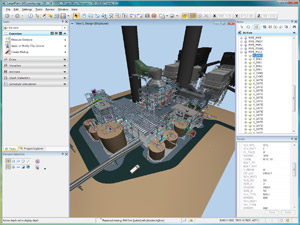
The key benefits of this new wrapper is that it is highly accurate for both 2D and 3D formats, offers bi-directional links for data to be taken back to the original CAD file and is self describing needing no additional application to display its content.
Bentley has a new term that it applies to i-models, saying that they have ‘provenance’, which means that an i-model always knows exactly where its original constituent files are and how it has evolved throughout the design process. This makes i-models self-managing.
While the data is lightweight, it is still highly accurate, the format supports digital rights management and digital signatures for control. The i-model files can also be time limited for granting ‘windows of access’. The high degree of accuracy means that clash detection, which can be done in Project Navigator, is not as suspect as other lightweight collaboration formats that approximate geometry using faceted models.
On large projects this approximated geometry can introduce poor results when tolerances are taken into consideration.
Users can export i-models from within MicroStation or other Bentley products. Bentley has also created a free i-model export plug-in for Autodesk Revit. For those without CAD systems, there is also a stand alone ProjectWise i-model Composer product, which can be used to import models and data from a variety of commonly used sources, packaged up and saved as a single i-model. Bentley describes the system as ‘open’ and has created an API development kit.
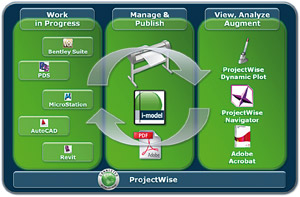
The i-models are optimised for purpose, enabling streamlined information exchange between collaborating teams. An i-model can also be data-independent and used to store information in multiple industry standards including CIS/2, IFC, and ISO 15926.
They are customisable to include the preferred level of information richness for different project and workflow uses.
The only weakness I could find in this idea is that at the time of launch no other vendor supports i-models. If this is to go beyond just Bentley workflows, it is essential that other vendors in the industry support export to the i-model format.
Project Navigator V8i
ProjectWise and Project Navigator have both been updated to handle the new i-model format, enabling Project Navigator to offer a broader and expanded role in federated workflows.
Buddy Cleveland, Bentley senior vice-president, Platform Technology, explained that even the best tools bring together a broad range of file formats but only enable static visualisation to identify problems. Bentley is trying to improve the technology by adding a dynamic element to Navigator and document the feedback that is added to project data as it is shared.
ProjectWise Navigator V8i can open DGN, DWG, and i-models, while 3D models can be manipulated in real-time, apply analysis measure and mark-up. The software allows the optimisation of schedules and has built-in clash detection. The rendering technology produces very good photorealistic rendering and outputs 2D/3D PDFs.
Navigator is obviously designed to work well with Bentley’s ProjectWise collaboration servers, which when combined offer additional services, such as notifying team members of any changes to their work. It is clear that with this offering, Bentley has Autodesk’s Navisworks in its sights, as Autodesk dramatically increased the Navisworks price to £10,000 for a full copy. As the number of team members that need this functionality increases with the size of the project, Bentley is pitching the ProjectWise collaboration servers and Navigator for considerably less, with many added benefits.
Awards
The glue that held the event together was the competition and awards evening. Post judging and prior to the ceremony, the attendees spent a few days listening to short presentations from each of the competition entries, showing how the software was used to complete the projects.

The variation in project scale and scope was quite diverse but the high standard to which the professionals were using CAD tools was really inspiring. Every presentation was given in 3D and not just for visual effect, these firms were getting the multiple benefits of building virtual models as digital prototypes. There were many presentations that were not visually rich, such as the changes being made to Chicago O’Hare airport, but the complexity of extending and amending an International airport and central hub while keeping the planes flying was an exceptional feat.
A number of UK firms were on the winners’ list: Mott MacDonald won the Communicating through Visualisation award for its model railway project, Feilden Clegg Bradley Studios won Innovation in Generative Design for the roof of Worcester Library and History Centre, and Edge Structures won the Innovation in Structural Engineering award for the brilliant Wimbledon Centre Court Redevelopment and Retractable Roof project. The Brits also won loudest tables at the gala dinner award, which has become a bit of a tradition!
Conclusion
The traditionally huge gatherings of CAD firms are always impressive but also always very impersonal. With only 300 people it takes on a very different dynamic and there is much more fusion between attendees, with lots of opportunity for interaction. I understand Bentley may well keep this event in addition to the huge BE conference next year, which will be in Bentley Systems’ hometown of Philadelphia. I also believe it may be broadcast live over the web.
With the focus being very much on the projects of Bentley’s customers, it was really inspiring to see 3D, analysis, rendering and project management tools being used everywhere at all points of the design process. The key takeaway from these users was that 3D meant all details of the project were explicit, which aided communication and understanding in the traditional and federated workflows that permeate our market.
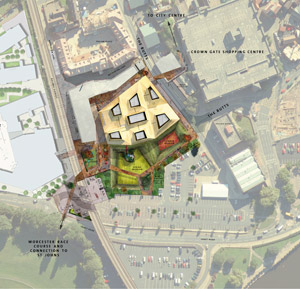
As to the announcements, Bentley is certainly listening to its customers and trying to ease the pain points in collaborative working with the updated Navigator and i-model technology. Last year’s introduction of Dynamic plot, which cleverly linked paper plots and mark-ups back to the digital model, was a key link. This new i-model format really builds on the digital process, as it is aimed at trying to overcome the problems that file formats always create, as well as solve future problems with evermore information added to design formats. We will have to see if the i-model format is accepted outside of the Bentley community for it to be called a success.
As usual, Bentley is a very technology driven company, being founded by the programming brothers. Twenty-five years on, Keith, Barry, Greg, Ray and Scott Bentley are still in Exton, developing MicroStation and frequently on the forums helping customers.
While what it has managed to create is sometimes not particularly obvious to those outside the MicroStation community, the company tends to develop elegant solutions on an ambitious scale, especially with respect to customers’ workflows and data over the long term. I have said it once and I will say it again, Bentley has only changed its file format once in the last 25 years and that takes some planning.






